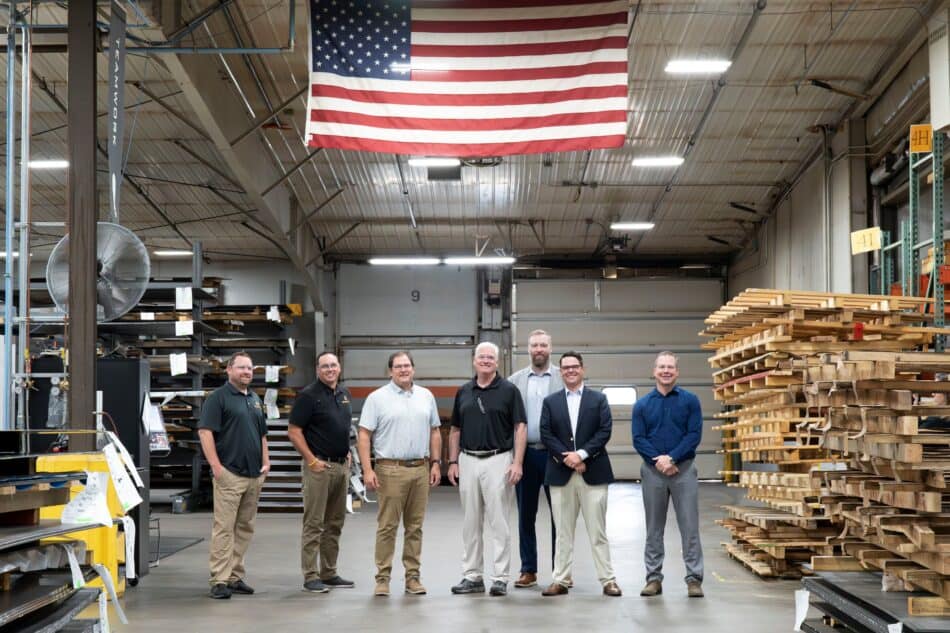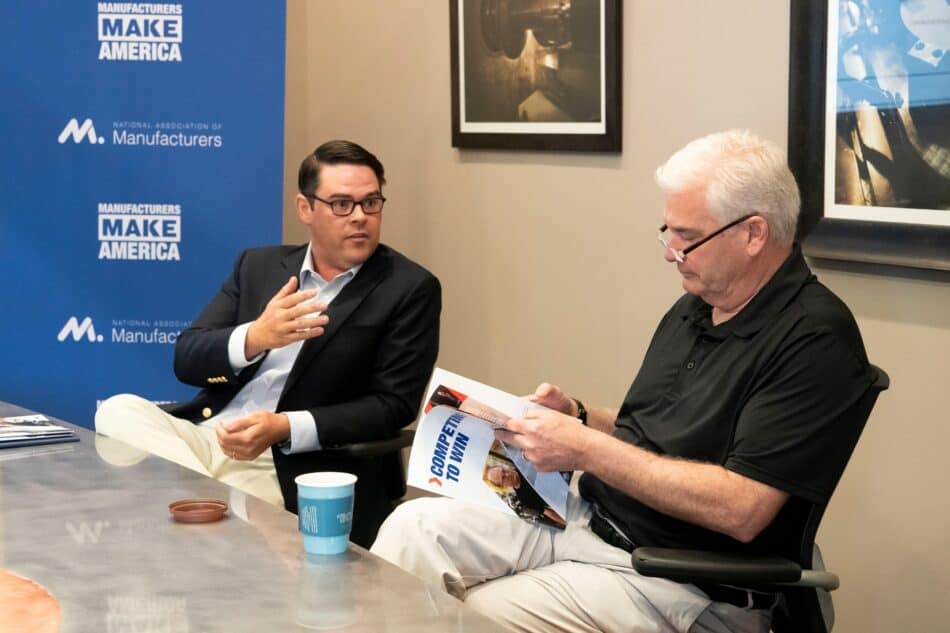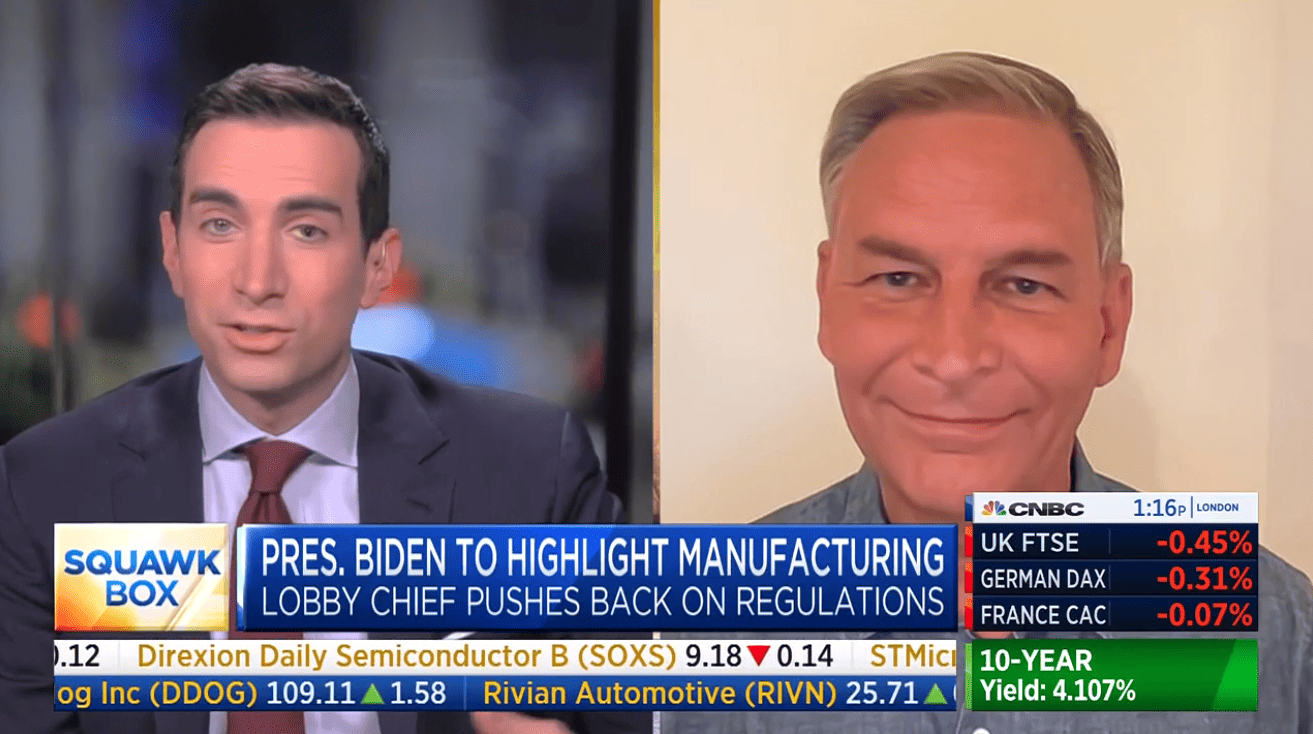House Majority Whip Emmer, NAM Spotlight Cost of Regulations and Policies to Boost Manufacturing
Princeton, MN – The National Association of Manufacturers hosted House Majority Whip Tom Emmer (R-MN) at Glenn Metalcraft for a facility tour on Monday to discuss the impact of the current regulatory burden manufacturers are facing across federal agencies.

Leaders also discussed manufacturers’ policy priorities as outlined in the latest version of “Competing to Win,” the NAM’s comprehensive blueprint to bolster manufacturers’ competitiveness.

“My visit to Glenn Metalcraft demonstrated the need to address the regulatory state overwhelming manufacturers in the heartland. Small and medium-sized manufacturers are working hard to grow their businesses and increase compensation for employees, but those efforts are undermined by new regulations and the lack of permanent, competitive tax policies to promote research and development and capital investment,” said House Majority Whip Tom Emmer. “I want to thank the National Association of Manufacturers and Glenn Metalcraft for providing insight that will guide my work in Congress.”
“Manufacturers across the country are fighting to thrive under the weight of an increasing number of unbalanced and often unfeasible regulations from agencies across the federal government—all amid an uncertain economic environment,” said Glenn Metalcraft President and CEO Joe Glenn. “Glenn Metalcraft would like to thank Whip Emmer and the National Association of Manufacturers for giving us a voice and calling attention to this issue.”
“Manufacturers are struggling to navigate substantial regulations from Washington on top of the deluge of new laws from St. Paul. We appreciate Whip Emmer for expanding our state-level efforts on the national stage,” said Minnesota Chamber President and CEO Doug Loon. “The National Association of Manufacturers is an excellent partner in championing policies for businesses to grow and compete globally. We appreciate their efforts with the Biden administration and Congress to hold agencies accountable and deliver sensible regulations.”
“The barrage of federal regulations from Washington has created serious concern across our industry, with manufacturers reporting that it’s standing in the way of job creation, investment and wage growth. Manufacturers have made it clear that the administration’s regulatory agenda could easily derail manufacturing’s recent success. Glenn Metalcraft and so many others are forced to make tough decisions as agencies issue unbalanced regulations that threaten our sector’s ability to grow and compete,” said NAM President and CEO Jay Timmons. “The positive effects of tax reform, the Bipartisan Infrastructure Law and the CHIPS and Science Act are all being undermined by the growing regulatory burden, and I want to thank Whip Emmer for spotlighting this threat in his home state of Minnesota.”
Background: Recently, the NAM, members of the NAM’s Council of Manufacturing Associations and Conference of State Manufacturers Associations launched Manufacturers for Sensible Regulations, a coalition addressing the impact of the current regulatory onslaught coming from federal agencies.
According to the NAM’s Q2 2023 Manufacturers’ Outlook Survey, more than 63% of manufacturers report spending more than 2,000 hours per year complying with federal regulations, while more than 17% of manufacturers report spending more than 10,000 hours. The NAM survey also highlighted that only 67% of manufacturers are positive about their own company’s outlook, the lowest percentage since Q3 2019. It shows the consequences of regulations: If the regulatory burden on manufacturers decreased, 65% of manufacturers would purchase more capital equipment, and more than 46% would increase compensation.
-NAM-
The National Association of Manufacturers is the largest manufacturing association in the United States, representing small and large manufacturers in every industrial sector and in all 50 states. Manufacturing employs nearly 13 million men and women, contributes $2.90 trillion to the U.S. economy annually and accounts for 55% of private-sector research and development. The NAM is the powerful voice of the manufacturing community and the leading advocate for a policy agenda that helps manufacturers compete in the global economy and create jobs across the United States. For more information about the NAM or to follow us on Twitter and Facebook, please visit www.nam.org.
Timmons on Regulations: Make Them “Sensible and Achievable”

“There are good things coming from [the Biden] administration”—including the CHIPS and Science Act and historic infrastructure investment—but there are also several trends that spell trouble for manufacturing in the U.S., NAM President and CEO Jay Timmons said on CNBC’s “Squawk Box” on Monday.
A three-fold issue: “On the one hand we have a manufacturing strategy that Congress and the administration have been putting forward, which is … to prioritize growing manufacturing here in the United States,” Timmons told CNBC’s Andrew Ross Sorkin.
- “But … you’re compounding that with three things. One is the [number] of regulations coming down. … [Two is] slow permitting, which is making it difficult for manufacturers to build those facilities they’re willing to invest in. Thirdly, [in] some of the provisions that have been enacted, there’s been confusing guidance or no guidance when it comes to accessing the funds and credits that are available for manufacturing. All three of those things together are making it very difficult for manufacturers to compete and succeed in our global economy.”
- The NAM is engaging on approximately 100 different regulations coming from 30 different government agencies, Timmons added.
Make regulation smart, achievable: Manufacturers are in favor of reasonable regulations that enable them to succeed, Timmons continued. “We’re not saying ‘No regulation’; we’ve never said that. What we’re saying is, ‘Let’s make these regulations essential, smart and achievable.’”
- He cited the National Highway Traffic Safety Administration’s new Corporate Average Fuel Economy Standards—which the NAM has told the administration are unworkably stringent and will drive up costs for manufacturers—as well as the Environmental Protection Agency’s new standards for ambient air quality, which a NAM-commissioned study found would threaten billions in economic activity and cost hundreds of thousands of jobs.
NAM in action: The NAM recently joined forces with members of its Council of Manufacturing Associations and the Conference of State Manufacturing Associations to launch Manufacturers for Sensible Regulations, a coalition created to address the negative effects of these federal regulations.
Amp Up Your Advocacy with the NAM’s Help

Ever wondered how best to contact your members of Congress? Or invite them on a tour of your facility? The NAM’s advocacy division, which helps manufacturers express their priorities to D.C. decision-makers, recently released a new and important resource: a suite of toolkits for different advocacy activities, including facility tours and more.
Congressional contact: There is an art to contacting Congress, as the NAM’s advocacy team will tell you. Their “Engaging Congress” toolkit provides simple, easy to remember rules for all types of communication, as well as sample letters and phone messages.
- By email: A few key tips include using a clear subject line, making sure that you identify yourself as a constituent and providing strong facts and data. And don’t forget to make it personal—the congressional office should understand that you yourself are harmed (or benefitted) by the policy in question.
- By phone: The advice for phone calls is similar—make sure you identify yourself as a constituent and a manufacturer, and that you have a clear request for the congressional staffer answering your call. Personal details matter in this format as well.
Lastly, consider attending town halls or other events hosted by your members of Congress, where you can also voice your opinions and connect with their offices.
Facility visits: Another way to make an impact on your representatives is to invite them over to your place. Hosting a facility tour can seem daunting or complicated, but the NAM’s toolkit breaks it down into eight easy steps. This collection of advice from the experts includes the following:
- How to create a guest list, send invitations and coordinate with congressional office staff
- How to prepare for media participation and craft a CEO message
- How to organize the tour itself, from preparing the premises to greeting the lawmaker to providing safety equipment and more
- How to show the visitors around while dropping key talking points into the conversation
That’s only a snapshot of this helpful toolkit, which includes many hints that you may not ever have considered—such as designating a notetaker to join the tour and keep a record of it.
Become an ambassador: If you are interested in making advocacy one of your missions, consider becoming an NAM Ambassador. Ambassadors share their stories with the media and policymakers, take public positions on key manufacturing issues, publish op-eds, host elected officials at their facilities and much more.
Check it out: Explore the whole toolkit and learn how you can become an effective public advocate for your company, your industry and the American economy.
SEC Finalizes Cybersecurity Disclosures Rule

After an aggressive campaign by the NAM, the U.S. Securities and Exchange Commission has scaled back a damaging cybersecurity proposal that would have been deeply problematic for manufacturers. Yet, the final regulations still impose compliance burdens on publicly traded companies. Here’s what manufacturers can expect now that the rule is finalized.
The background: Last year, the SEC proposed a new set of cybersecurity disclosure requirements for public companies. The centerpiece of the rule was a mandate to disclose cybersecurity incidents to the public within four days. The proposal also would have required detailed reporting on companies’ policies and procedures for responding to cybersecurity threats.
The problem: Requiring detailed public disclosures about cybersecurity incidents and processes could provide a roadmap to potential hackers, and sharing information about ongoing incidents could compromise efforts to stop an attack.
The NAM response: The NAM urged the SEC to make commonsense adjustments to protect manufacturers from attacks and give companies the flexibility to respond to cybersecurity incidents appropriately.
The result: The final rule is more tailored than the initial proposal, reducing the risk that companies will be forced to expose sensitive information. But its requirements still impose new compliance burdens on manufacturers.
Incident reports: The rule still requires companies to report cybersecurity incidents publicly within four days, but companies will be able to request that the attorney general grant a 30-day extension to protect public safety or national security—a top priority for the NAM. The extension could be lengthened by an additional 30 days (for public safety) or 90 days (for national security) if warranted.
- Thanks to the NAM’s intervention, the SEC will require the disclosure of only limited information about an attack’s circumstances and impact, whereas the original proposal would have forced companies to disclose extensive details, including potentially sensitive data.
- In addition, a provision requiring companies to track, aggregate and disclose the impact of minor cybersecurity incidents—which the NAM opposed—was struck from the final rule.
Risk management and governance: Companies will be required to disclose information on cybersecurity oversight by their board and management, as well as how cybersecurity is incorporated into their overall risk management strategy.
- These disclosures must include “sufficient detail for a reasonable investor to understand” a company’s cybersecurity risk management—but will no longer include information on a company’s specific prevention and detection activities.
- A provision effectively requiring companies to have a cyber expert on their board, which the NAM strongly opposed, was not included in the final rule.
Our take: “The NAM is committed to a smart, flexible disclosure approach that ensures manufacturers—and their customers and shareholders—can stay protected from cybersecurity threats,” said NAM Senior Director of Tax and Domestic Economic Policy Charles Crain.
- “Manufacturers were glad to see that the SEC made some adjustments to its rule, but more must be done. The SEC and the Department of Justice must grant companies the flexibility to delay incident reporting to prevent threats to public safety and national security.”
Get protected: Every manufacturer should have the tools they need to protect themselves against cyberattacks. Check out NAM Cyber Cover—an exclusive cybersecurity and risk mitigation program for NAM member companies and organizations.
Manufacturers: DOE Gas Stove Rules Revision Is Step in Right Direction
Washington, D.C. – Following the announcement that the U.S. Department of Energy has modified its proposed energy-efficiency rules for gas stoves to be less restrictive, National Association of Manufacturers Managing Vice President of Policy Chris Netram released the following statement:
“Manufacturers depend on regulatory clarity and certainty. Throughout the year, the Department of Energy has proposed an unprecedented slew of regulations, and many were aimed at home appliances. The DOE is now taking steps toward a solution that is less likely to raise production costs significantly for manufacturers, and less likely to reduce the available features, performance and affordability for consumers.
“Manufacturers remain committed to working with the DOE and all federal agencies to ensure that proposed rules and regulations are practical, feasible and environmentally sound without harming our ability to create well-paying jobs and investment in the United States.”
The NAM, along with members of the Manufacturers for Sensible Regulations, have been highlighting the negative impact of unbalanced regulations on manufacturers, noting the agency’s own data showed that 96% of existing gas stove models currently available would not comply.
Background: According to the NAM’s Q2 2023 Manufacturers’ Outlook Survey, more than 63% of manufacturers report spending more than 2,000 hours per year complying with federal regulations, while more than 17% of manufacturers report spending more than 10,000 hours. The NAM survey also stressed that only 67% of manufacturers are positive about their own company’s outlook, the lowest since Q3 2019. It shows the consequences of regulations: If the regulatory burden on manufacturers decreased, 65% of manufacturers would purchase more capital equipment, and more than 46% would increase compensation.
-NAM-
The National Association of Manufacturers is the largest manufacturing association in the United States, representing small and large manufacturers in every industrial sector and in all 50 states. Manufacturing employs nearly 13 million men and women, contributes $2.91 trillion to the U.S. economy annually and accounts for 55% of private-sector research and development. The NAM is the powerful voice of the manufacturing community and the leading advocate for a policy agenda that helps manufacturers compete in the global economy and create jobs across the United States. For more information about the NAM or to follow us on Twitter and Facebook, please visit www.nam.org.
NAM Pushes Back on New Emissions Standards

The Biden administration’s new fuel-economy standards are too aggressive and add conflicting mandates to on-the-books regulations, the NAM said Friday.
What’s going on: The Department of Transportation’s National Highway Traffic Safety Administration issued a proposal calling for a revision of current Corporate Average Fuel Economy standards for cars and light-duty trucks—to a fleet average of 58 miles per gallon by 2032.
- The draft rules are a complement to regulations released “in April that are the strictest on record and push automakers to make the majority of their sales electric vehicles,” reports Auto Dealer Today.
Why it’s problematic: “Auto manufacturers have been making historic investments to ensure that electric vehicles will have a growing place on America’s roads,” said NAM President and CEO Jay Timmons. “However, the NAM has concerns over the three different sets of standards governing light- and medium-duty vehicles. For instance, the Environmental Protection Agency’s proposed regulation on light- and medium-duty vehicles would require 67% of new manufactured vehicles to be battery electric by 2032 and is too aggressive.”
- Some of the rules that have been put forth recently by federal and state agencies conflict with one another, and some—particularly those released by the EPA—would increase the cost of both manufacturing and purchasing vehicles.
- “In addition, the federal government should not dictate the vehicle choices offered to consumers,” Timmons pointed out. “The administration should allow the market and consumers to grow the number of electric vehicles, rather than depending on a single technology to meet this goal.”
What can be done: “[T]hese regulations should be harmonized to create a single unified standard for vehicle emissions, so manufacturers do not have to navigate three often-conflicting targets, which raise costs for manufacturers and consumers,” Timmons continued.
What we’re doing: In June, the NAM and members of the NAM’s Council of Manufacturing Associations and Conference of State Manufacturing Associations launched Manufacturers for Sensible Regulations, a coalition aimed at addressing the negative effects of the multiple, often contradictory regulations being handed down by federal agencies.
Manufacturers to White House: Emissions Standards Adding Unnecessary Costs, May Stifle Innovation
Washington, D.C. – In response to the National Highway Traffic Safety Administration’s release of new Corporate Average Fuel Economy standards, National Association of Manufacturers President and CEO Jay Timmons released the following statement:
“Auto manufacturers have been making historic investments to ensure that electric vehicles will have a growing place on America’s roads. However, the NAM has concerns over the three different sets of standards governing light- and medium-duty vehicles. For instance, the Environmental Protection Agency’s proposed regulation on light- and medium-duty vehicles would require 67% of new manufactured vehicles to be battery electric by 2032 and is too aggressive.
“Federal and state agencies are promulgating competing rules, and the EPA’s rules, in particular, would make it costlier for manufacturers to make these vehicles and for consumers to purchase them. When you add the drastic need to build transmission lines to accommodate the demand for charging infrastructure and the challenge of obtaining critical minerals for batteries—many of which are extracted or processed in China—you create a scenario where an ambitious rule becomes a nearly impossible benchmark.
“Consumers and the industry need a more realistic path to reducing vehicle emissions. Federal and state agencies should draft rules that recognize the longer timeframe needed for our nation to build the charging infrastructure and a reliable supply chain for the critical minerals to make batteries to support more electric vehicles. Rules should also be structured to allow the industry additional time to make more electric vehicles available for consumers, and in the quantities needed to eventually achieve the administration’s goals. In addition, the federal government should not dictate the vehicle choices offered to consumers in meeting this goal. Plug-in hybrids, fuel cell electric vehicles and battery-electric cars can all help reduce vehicle emissions over time. The administration should allow the market and consumers to grow the number of electric vehicles, rather than depending on a single technology to meet this goal.
“Finally, these regulations should be harmonized to create a single unified standard for vehicle emissions, so manufacturers do not have to navigate three often-conflicting targets, which raise costs for manufacturers and consumers. The NAM looks forward to working with the administration to ensure vehicle standards meet consumer demand while providing manufacturers in the U.S. more opportunities to create jobs, develop new technologies and become even more globally competitive.”
Background: Recently, the NAM, members of the NAM’s Council of Manufacturing Associations and Conference of State Manufacturers Associations launched Manufacturers for Sensible Regulations, a coalition addressing the impact of the current regulatory onslaught coming from federal agencies.
According to the NAM’s Q2 2023 Manufacturers’ Outlook Survey, more than 63% of manufacturers report spending more than 2,000 hours per year complying with federal regulations, while more than 17% of manufacturers report spending more than 10,000 hours. The NAM survey also highlighted that only 67% of manufacturers are positive about their own company’s outlook, the lowest since Q3 2019. It shows the consequences of regulations: If the regulatory burden on manufacturers decreased, 65% of manufacturers would purchase more capital equipment, and more than 46% would increase compensation.
-NAM-
The National Association of Manufacturers is the largest manufacturing association in the United States, representing small and large manufacturers in every industrial sector and in all 50 states. Manufacturing employs nearly 13 million men and women, contributes $2.91 trillion to the U.S. economy annually and accounts for 55% of private-sector research and development. The NAM is the powerful voice of the manufacturing community and the leading advocate for a policy agenda that helps manufacturers compete in the global economy and create jobs across the United States. For more information about the NAM or to follow us on Twitter and Facebook, please visit www.nam.org.
Michigan Homebuilders Push Back on Air Quality Proposal

“Policy can’t be developed in a vacuum,” says Dawn Crandall, executive vice president of government relations for the Home Builders Association of Michigan. “People need to look at how one policy impacts that next thing. Everything is tied together.”
That’s Crandall’s message for the Environmental Protection Agency, as it considers a proposed air quality rule to restrict particles called PM2.5. While the regulations might not appear to impact the housing industry directly, they could prevent manufacturers from expanding facilities and creating jobs in Michigan—which does affect the housing market.
The concern: If manufacturers are unable to grow in the state or open new facilities, fewer people will need housing. That’s bad news for homebuilders.
- “If you put in these EPA regulations that are going to create a barrier for companies looking to move here, and then they decide they don’t want to, that’s going to impact Michigan’s ability to be an economic destination,” said Crandall.
- “And if you make it harder for businesses to employ employees, then they don’t need housing. That has a big impact on us.”
A shaky foundation: Michigan’s housing industry is still recovering from the significant downturn it experienced about 15 years ago.
- That slump was dramatic: according to Crandall, the number of permits filed in Michigan for single-family homes fell sharply from 54,721 in 2005 to around 15,000 two years later, bottoming out to about 6,900 in 2009.
- Although the industry has seen some recovery since then, new construction remains relatively low, and Crandall worries that shocks caused by the EPA’s proposed regulations could do further harm.
- “I think we’ve hit rock bottom, and we’re slowly coming out of it,” said Crandall. “But we’re only projecting 16,000 single-family permit builds this year—and anything that’s going to impact residential construction is not good for the state of Michigan.”
Another challenge: Ultimately, Crandall is concerned that the EPA’s proposed rule will simply add to a long list of challenges for homebuilders.
- “We’re already facing enough hurdles,” said Crandall. “There’s a lack of skilled workers who can do residential construction. Material costs peaked during COVID. We get a lot of our lumber from Canada, so these Canadian wildfires could have an impact. So if PM2.5 is going to affect economic development in our state, that’s going to have an impact on us, too.”
The big idea: “We’re all connected in some form or fashion,” said Crandall. “Michigan needs to grow our population, and we can’t do that if companies don’t bring people into our state who want to live, work and play here. We’re one big ecosystem.”
House Financial Services Approves NAM-Supported ESG Package

The House Financial Services Committee has spent the last month holding hearings about environmental, social and governance policies that impact American businesses—and the NAM has been fighting for manufacturers every step of the way. This week, the committee held a markup to pass a package of legislation on the topic, and the NAM’s priorities were front and center.
The issue: Manufacturers in the U.S. are at the forefront of climate stewardship and innovation even as they power the U.S. economy, yet politically motivated activists and proxy advisory firms are making it difficult for manufacturers to succeed.
- Recent actions from the U.S. Securities and Exchange Commission have empowered these groups. From unworkable ESG disclosure mandates to new standards encouraging shareholder activism to a lack of oversight of proxy firms, manufacturers are getting squeezed.
NAM in action: The NAM has advocated aggressively on behalf of manufacturers, pressing Congress to curb the impact of activists, proxy firms and the SEC on public company governance.
- NAM President and CEO Jay Timmons urged Congress to make changes that would protect manufacturers and Main Street investors, while NAM Managing Vice President of Policy Chris Netram testified before the Financial Services Committee about the need for action.
- “Congress must step in to depoliticize the business decisions that impact the lives and life savings of millions of Americans,” said Timmons. “Manufacturers are determined to create jobs, lead the economy and improve the quality of life for all Americans. We are counting on [Congress’] leadership to counter the SEC’s regulatory overreach and help us achieve these goals.”
The result: The House committee has embraced the NAM’s proposed reforms, a huge victory for manufacturers across the United States. The legislation approved by the committee this week would:
- Prevent activists from hijacking the proxy ballot in pursuit of agendas unrelated to long-term business growth and shareholder value creation;
- Rein in proxy advisory firms and limit their outsized influence on corporate governance;
- Reinforce asset managers’ fiduciary duty to Main Street investors and retirees; and
- Ease ESG disclosure mandates by requiring that public companies only report information that is material to their shareholders.
The last word: “Manufacturers strongly support the Financial Services Committee’s efforts to rein in the SEC’s regulatory overreach, keep activists out of the boardroom and protect Americans’ investments in manufacturing growth,” Netram said prior to the committee’s markup. “[W]e look forward to working with [Congress] to ensure that manufacturers can continue to drive economic expansion in the U.S. and support American competitiveness on the world stage.”
Manufacturers Should Be Cautiously Optimistic About the Economy

With a recession so far failing to materialize and inflation showing signs of weakening, manufacturers may begin to grow less wary about the economy. Recent data suggests that despite continuing risks, the bright spots may win the day.
Growth: GDP grew at a 2.4% annual rate in the second quarter of 2023. This number is notably higher than the 2.0% growth that analysts had expected for the quarter.
Employment: The overall employment rate sits at a very low 3.6%, defying expectations that the Fed’s inflation-reduction moves might create a surge in unemployment. Meanwhile, women in particular are enjoying an employment renaissance, including in manufacturing.
- Manufacturing had about 3,786,000 female employees in June, meaning that women made up 29.1% of the industry’s workforce, according to NAM Chief Economist Chad Moutray.
- That number is just slightly lower than the 3,788,000 found in May, which was the highest number of female workers in manufacturing since September 2009.
Wages: At the same time that overall economic strength is growing, the United States is also seeing positive signs in wage inequality, with average income for the lowest-earning 50% of Americans increasing faster than all other population groups except for the ultra-wealthy.
Inflation: Inflation has been a significant pain point for manufacturers, but it now seems to be moderating. According to the latest Consumer Price Index data, inflation rose 3% in June from a year earlier—a big drop from the whopping 9.1% annual inflation rate in June 2022.
The last word: “Real GDP data suggests that while demand and output in the manufacturing sector remain challenged, there are other pockets of strength in the larger macroeconomy,” said Moutray.
- “The Federal Reserve is working to navigate a ‘soft landing’—something that is possible, even as recession risks continue to permeate the conversation.”
